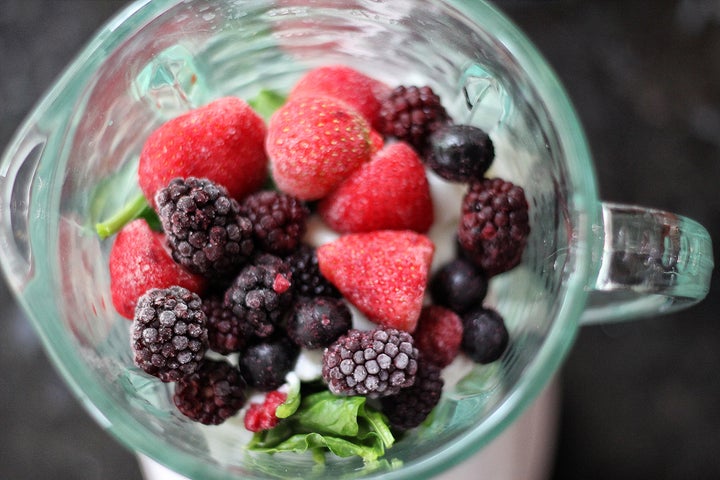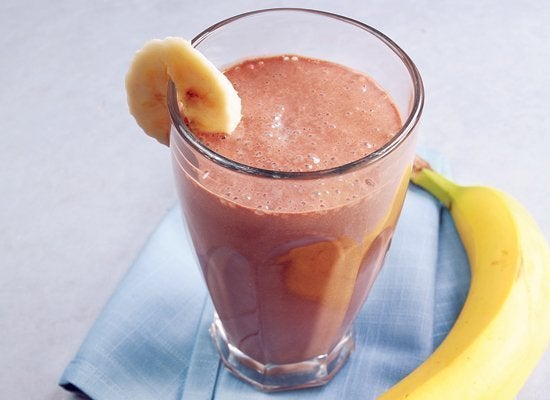Smoothies can be a great way to start the day or refuel after a workout, but without the right balance of ingredients you can end up with a sugar-loaded drink that will spike your blood sugar levels and leave you hungry shortly afterward.
“When made properly, smoothies can be an easy and convenient way to pack a lot of nourishment into one glass,” Rebecca Ditkoff, a registered dietitian nutritionist and founder of Nutrition by RD, told HuffPost. “Although the primary ingredient is fruit, which is nourishing and beneficial in proper portions, it is still possible to have too much of a good thing,” Ditkoff said.
She noted that the amount of sugar in a fruit-forward smoothie can quickly add up and even reach levels comparable to a soda (Liquiteria’s mean green smoothie has 47.5 grams of sugar while a 16-ounce Coke has 52 grams of sugar), especially if it’s not balanced with other ingredients.
Ditkoff recommended skipping fruit juice, which lacks fiber, and limiting the total amount of fruit for one smoothie to 1 cup. Meaning that if you’re mixing different fruits like bananas and berries, use half of a small banana and a half cup of berries.

Meredith Price, a plant-based registered dietitian nutritionist and owner of Priceless Nutrition & Wellness, told HuffPost that using too much fruit and not enough vegetables, and choosing bases with added sugars (such as sweetened non-dairy milk or fruit juice) are some common mistakes people make when crafting smoothies at home.
Jess Swift, a chef and registered dietitian, had similar thoughts and added that insufficient fiber is another common mistake. On the added sugar front, she noted that fruits like mango and pineapple are high on the glycemic index (meaning they’re digested faster and cause a higher and faster rise in blood sugar levels compared to low GI foods) and flavored yogurts have surprisingly high amounts of sugar.
Nutritionist-Approved Ingredients
Maximum 1 cup of fruit, plus plenty of vegetables: A smoothie can help you get in your daily recommended 2 1/2 cups of vegetables and two cups of fruit through just one nutrient-packed drink. “Fruits and vegetables also provide many beneficial nutrients like fiber, vitamins, minerals and antioxidants,” Price said. “Fiber slows down digestion, aids in controlling blood sugar and helps keep us satiated.”
As for specific fruits and vegetables to add, Price’s go-tos are greens (like kale and spinach), bananas and berries. “I always add at least half of a banana because it gives a nice, thick texture to the smoothie,” Price said. “Berries are also wonderful to use because they have the highest fiber content when it comes to fruits.” Pro tip: using frozen fruit makes your smoothies cold without diluting the mixture the way ice would.
Maximum 1-2 tablespoons nut butters: Like fiber, protein also slows down digestion and helps keep us full. Price recommended adding nut butters to smoothies, as they’re a healthy source of satiating fat and protein.
Maximum 1-2 tablespoons seeds: Price noted that chia seeds, ground flax seeds and hemp seeds add an extra boost of fiber, healthy fats, protein and omega-3s to smoothies. Ditkoff also likes using nuts and seeds in smoothies, but recommends capping these add-ins at 1-2 tablespoons as the calories can add up quickly.
Maximum 1/2 cup Greek yogurt: Recommended by Ditkoff, Greek yogurt is packed with protein, probiotics and other nutrients.
Maximum 1/4 avocado: “Adding avocado to a smoothie not only creates a nice creamy texture, it also adds a boost of heart-healthy monounsaturated fats,” Ditkoff said.
Unsweetened liquid base: Ditkoff pointed out that while choosing a smoothie base often comes down to personal preference or dietary needs, you should avoid using anything that’s been sweetened. Examples of unsweetened bases include unsweetened almond milk (or other nut milks), milk (whole, 2 percent, etc.) and coconut water.
Price prefers to use soy milk because of its higher protein content compared to other non-dairy milks.
Swift recommended blending water, unsweetened coconut milk and spinach for a nutrient-packed green base.
A scoop of protein powder: “Adding in plant-based protein powders like pea powder is a great way to bump up the protein without the saturated fat,” Swift said.
Whey and hemp powder are also good options, and Ditkoff noted that adding these to a smoothie can help to ensure an adequate amount of protein, as they contain about 15-25 grams of complete protein per serving.
Nutritionist-Approved Smoothies
Meredith Price
1:1:2 ratio for base, fruit and vegetables
- 1 cup soy milk
- 1/2 banana
- 1/2 cup of another fruit (like apple)
- 2 cups of vegetables
- 1 tablespoon nut butter
- 1 to 2 tablespoons seeds
Rebecca DItkoff
1/2 non-starchy vegetables, 1/4 protein and 1/4 carbohydrate or starch, plus 1 serving of fat
- 2 cups of vegetables (greens like spinach, kale or zucchini, or cauliflower rice)
- 1/2 cup Greek yogurt or a scoop of whey or hemp protein
- 1 cup max of fruit (1/2 small banana and 1/2 cup of frozen berries)
- 1/4 avocado or 1-2 tablespoons of almond butter, chia seeds, hemp seeds or flax seed
- 1 cup unsweetened liquid base (more or less, depending on the desired smoothie consistency)
Jess Swift
Sugar-free base, fruit with a low glycemic index and nutrient-filled kale
- 1 scoop pea protein powder
- 1 large handful kale
- 1/2 cup frozen blueberries
- 1 tablespoon chia seeds
- 1/2 cup ice
- 1/2 cup water
- 1/2 cup unsweetened almond milk
